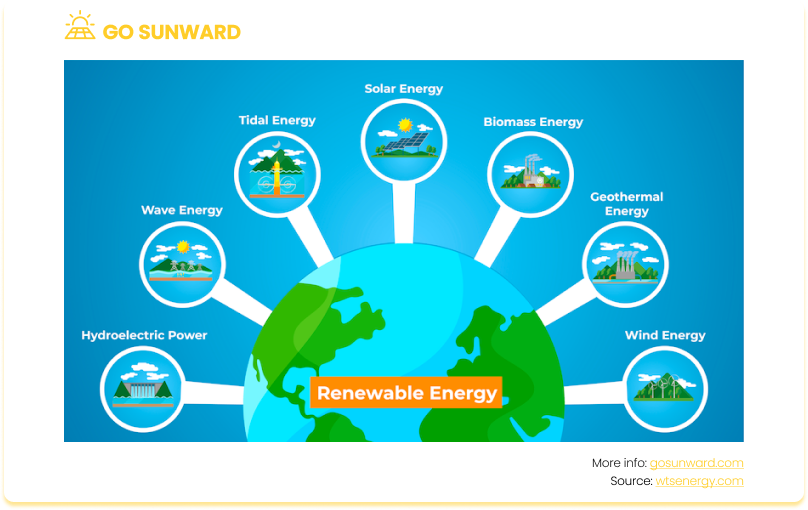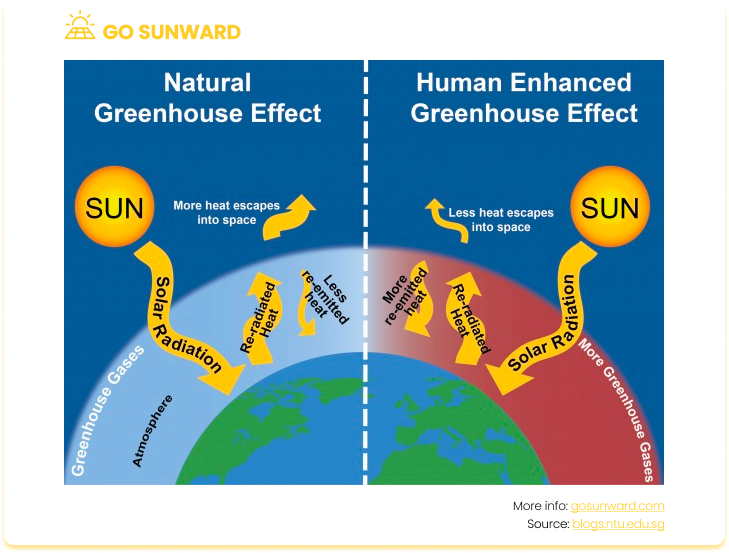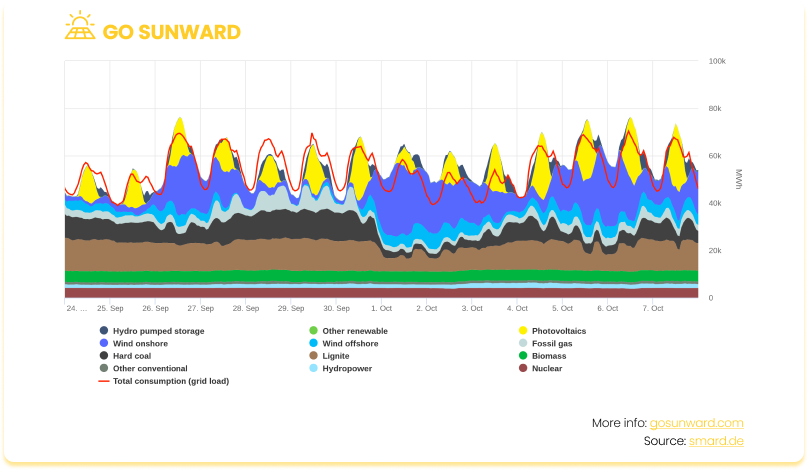Can Renewable Energy Stop Global Warming?
In the face of escalating climate change challenges, the quest for sustainable solutions has intensified, and renewable energy has emerged as a prominent contender to stop global warming. As the world grapples with the urgent need to curb greenhouse gas emissions and mitigate the impacts of global warming, renewable energy sources, such as solar, wind, hydro, geothermal, and biomass, have gained traction for their potential to revolutionize the energy landscape.
This article delves into whether renewable energy can stop global warming. It examines its strengths, limitations, and the transformative role it can play in transitioning to a low carbon global future. To answer the question ‘can renewable energy stop global warming’, we first need to define and examine the concepts of renewable energy and climate change.
Table of Contents
Renewable Energy 101
Renewable energy refers to energy obtained from naturally occurring sources that are continually replenished and do not deplete over time. These sources provide a sustainable and environmentally friendly alternative to finite fossil fuels, such as coal, gas and oil. Renewable energy technologies harness these abundant resources to generate electricity and heat without emitting carbon emissions or depleting natural reserves. The technologies are also often referred to as green energy or clean energy.
Currently, the most widely used renewable energy sources include:
- Solar power – derived from the sun’s radiation
- Wind energy – wind turbines capture the kinetic energy of the wind
- Hydroelectric – generated by harnessing the energy of moving water, typically in rivers or dams
- Geothermal energy – heat derived from the Earth’s core, harnessed to produce electricity or provide heating and cooling
- Tidal & wave energy – captures the energy from the movement of ocean tides and waves
- Biomass energy – derived from organic materials such as agricultural residues, wood, and organic waste, which can be used for electricity generation or heating.
These technologies are being increasingly deployed worldwide as concerns about global warming rise and governments and consumers pursue sustainable energy alternatives. To find out more about individual renewable energy technologies and their uses, click here.

Climate Change 101
Climate change refers to long-term alterations in Earth’s climate patterns and weather conditions, particularly concerning temperature, precipitation, and wind patterns, resulting from various natural and human-induced factors. While climate variations are normal and have occurred throughout Earth’s history, the term “climate change” specifically refers to the recent and rapid changes observed over the past century, largely driven by human activities.
The primary driver of modern climate change is the unprecedented increase in greenhouse gas emissions, mainly carbon dioxide (CO2), methane (CH4), and nitrous oxide (N2O). These gases trap heat in the Earth’s atmosphere, forming a “greenhouse effect.” As human activities such as burning fossil fuels (coal, oil, and natural gas), deforestation, agriculture, and industrial processes release vast quantities of greenhouse gases, the planet’s average temperature rises.

Climate change has significant and widespread effects. One of the most pertinent effects is global warming, leading to rising sea levels due to the melting of polar ice caps and glaciers. This poses a severe threat to coastal communities, infrastructure, livelihoods, and ecosystems. Additionally, changes in weather patterns result in more frequent and intense extreme weather events, including heatwaves, droughts, floods, hurricanes, and storms, which impact food, water and energy security. Climate change also exacerbates ecological disruptions, affecting biodiversity, species migration, and ecosystems’ delicate balance. Changes in temperature and precipitation patterns can lead to shifts in plant and animal populations, disrupting food chains and threatening many species’ survival.
Given the severe and widespread repercussions climate change can have, it is essential that collective global efforts are deployed to mitigate it. This is where international agreements play a crucial role in promoting the implementation of renewable energy to stop global warming or slow it down as much as possible.. The most notable agreement is the Paris Agreement (adopted in 2015) aims to limit global warming to well below 2 degrees Celsius above pre-industrial levels and pursue efforts to limit the increase to 1.5 degrees Celsius. A key component of global climate change strategies is adopting low-carbon energy sources in a bid to reduce emissions.
The Renewable Energy-Climate Change Nexus
Renewable energy is set to play a crucial role in climate change policy and the world’s transition to a lower-carbon economy because of its sustainable, low-emissions nature. Renewable energy technologies, such as solar panels and wind turbines, produce minimal greenhouse gas emissions during their operation. Therefore, by using renewable energy to generate electricity or for heating purposes, individuals, businesses, and policymakers are reducing reliance on fossil fuels. In other words, the more renewable energy is used, the less fossil fuel-based electricity is needed. This reduction in fossil fuel consumption directly translates into lower emissions.
While life cycle emissions of renewable energy technologies are not zero (life cycle emissions encompass the stages of production, transportation, installation, and disposal), they are typically much lower compared to the GHG emissions that would result from using conventional fossil fuel-based electricity sources to generate the same amount of power throughout the renewable energy technologies’ operational lifespan.
According to various studies and scenarios, widespread adoption of renewable energy technologies has the potential to significantly reduce CO2 emissions. The International Renewable Energy Agency (IRENA) estimates that doubling the share of renewable energy in the global energy mix by 2030 could avoid up to 12 gigatonnes of energy-related CO2 emissions in 2030.
Barriers To Adopting Renewable Energy To Stop Global Warming and Climate Change
Rere are still several barriers that will hinder adoption of renewable energy over the coming years. Here we will examine the most pertinent and discuss their potential solutions.
1) Intermittency
Intermittency issues are one of the critical challenges associated with renewable energy sources. Unlike fossil fuel-based power generation, which can provide a consistent and predictable electricity supply, most renewable energy sources, such as solar and wind, depend on natural factors like weather conditions and sunshine. This results in fluctuations in energy availability from renewable sources, making them intermittent and potentially unreliable.

For example, solar power generation relies on sunlight, which is unavailable at night and can vary based on cloud cover and seasonal changes. Wind power depends on wind speed, which can be inconsistent and vary over time. These variations in energy production can lead to periods of both excess energy and energy shortages, creating challenges for maintaining a stable and reliable electricity grid.
One effective solution to address the intermittency issues of renewable energy is energy storage technology. Energy storage systems, such as batteries and pumped hydro storage, can store excess energy generated during periods of high renewable output and release it when renewable sources are producing less or not at all. By balancing energy supply and demand, these storage solutions help stabilize the electricity grid and ensure a continuous and reliable power supply, overcoming the variability of renewable energy sources.
2) Upfront capital costs and supportive infrastructure
Another challenge facing renewable energy adoption is the initial high cost of implementation and the need for supportive infrastructure to be in place. While renewable energy technologies have become more cost-effective over the years, their initial setup and installation expenses can be significant, especially for utility-scale projects. These costs encompass the manufacturing and procuring of solar panels, wind turbines, hydropower plants, geothermal installations, and energy storage systems.
Additionally, the need for updated grid infrastructure and energy storage solutions to accommodate variable and decentralized renewable energy sources adds to the overall costs. Many regions may not have the necessary grid infrastructure to efficiently integrate renewable energy into their existing power systems, requiring substantial investments in grid upgrades and interconnections.
Technology costs for renewable energy, particularly solar, have fallen dramatically over recent decades, making them an increasingly affordable option for electricity generation. Our research shows that this trend will continue over the coming decade, reducing the barrier of inhibitive costs. For example, by 2030, the global weighted average levelized cost of electricity (LCOE) for solar photovoltaics (PV) is forecast to fall by 58% from 2018.
The Future Of Renewable Energy To Stop Global Warming
The role of renewable energy in climate change is undeniable. With renewable energy technology costs continuing to fall and global efforts to combat climate change intensifying, the future of renewable energy appears promising and pivotal in shaping a sustainable and low-carbon energy landscape. As governments, businesses, and individuals recognize the urgent need to transition away from fossil fuels and reduce greenhouse gas emissions, renewable energy sources have emerged as a critical solution to address both the environmental and economic challenges of the future.
In addition to cost reductions and climate-driven policies, the future of renewable energy is also intertwined with ongoing research and innovation. Advancements in energy storage technologies, grid management systems, and renewable energy integration are vital to overcoming the intermittency challenges of renewable sources and ensuring a reliable and stable energy supply.
By channeling financial resources into renewable energy projects, governments, businesses, and individuals can drive the global transition to a low-carbon and sustainable energy future. The IEA suggests that to reach net zero emissions by 2050, annual clean energy investment worldwide will need to more than triple by 2030 to around US$4 trillion, aligning with our own assumptions. Supporting renewable energy expansion through investment is not only essential for addressing climate change but also for enhancing energy security, reducing air pollution, and ensuring a more resilient energy system for future generations.




